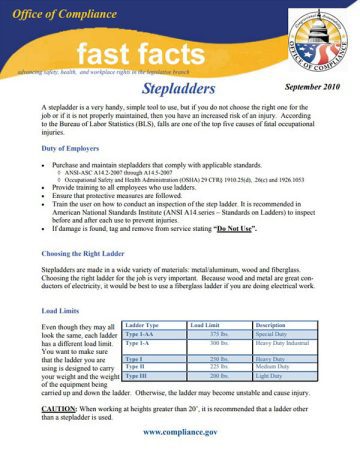A stepladder is a very handy, simple tool to use, but if you do not choose the right one for the job or if it is not properly maintained, then you have an increased risk of an injury. According to the Bureau of Labor Statistics (BLS), falls are one of the top five causes of fatal occupational injuries.
Duty of Employers
- Purchase and maintain stepladders that comply with applicable standards
- ANSI-ASC A14.2-2007 through A14.5-2007
- Occupational Safety and Health Administration (OSHA) 29 CFR§ 1910.25(d), .26(c) and 1926.1053
- Provide training to all employees who use ladders.
- Ensure that protective measures are followed.
- Train the user on how to conduct an inspection of the step ladder. It is recommended in American National Standards Institute (ANSI A14.series – Standards on Ladders) to inspect before and after each use to prevent injuries.
- If damage is found, tag and remove from service stating “Do Not Use”.
Choosing the Right Ladder
Stepladders are made in a wide variety of materials: metal/aluminum, wood and fiberglass. Choosing the right ladder for the job is very important. Because wood and metal are great conductors of electricity, it would be best to use a fiberglass ladder if you are doing electrical work.
Load Limits
Even though they may all look the same, each ladder has a different load limit. You want to make sure that the ladder you are using is designed to carry your weight and the weight of the equipment being carried up and down the ladder. Otherwise, the ladder may become unstable and cause injury.
| Ladder Type | Load Limit | Description |
| Type 1-AA | 375 lbs. | Special Duty |
| Type 1-A | 300 lbs. | Heavy Duty Industrial |
| Type I | 250 lbs. | Heavy Duty |
| Type II | 225 lbs. | Medium Duty |
| Type III | 200 lbs. | Light Duty |
CAUTION: When working at heights greater than 20’, it is recommended that a ladder other than a stepladder is used.

